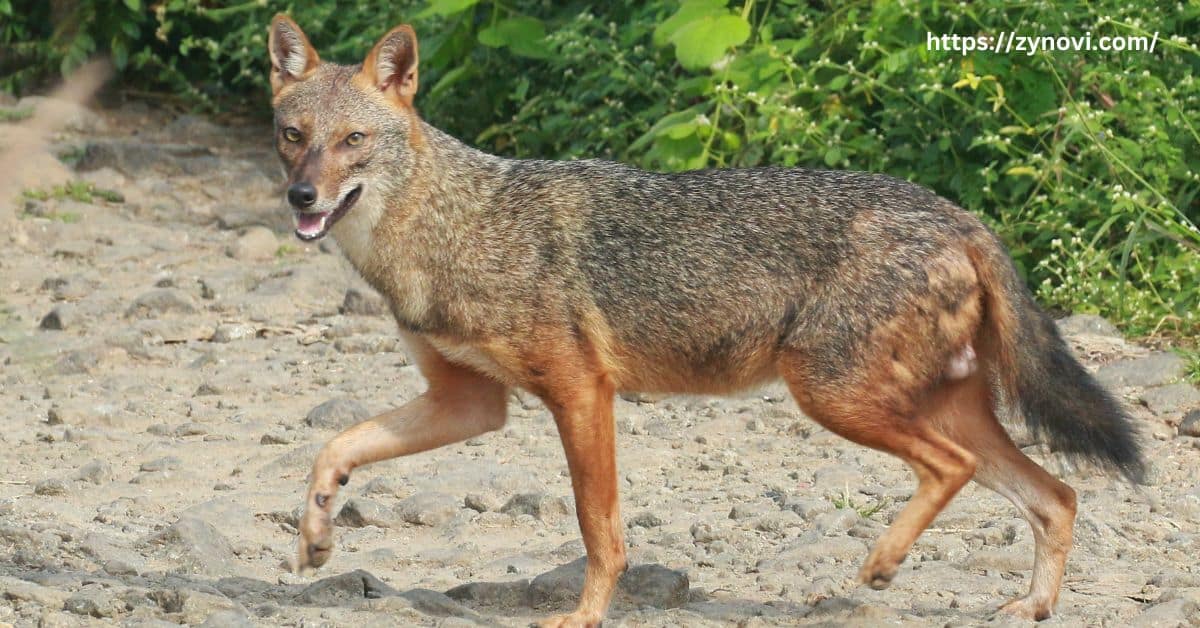Do jackals attack humans? Jackals rarely attack humans, and most encounters are peaceful or result from accidental proximity.
If you’ve ever wondered about the safety of being around these wild creatures, you’re not alone. Jackals are often misunderstood, and many people fear their presence, but how real is the danger? In this article, we’ll explore what really happens when humans encounter jackals and break down the myths surrounding these animals.
You might be surprised to learn that jackal attacks on humans are extremely rare. However, certain circumstances can escalate their behavior, making understanding them crucial for your safety. Stick with us to uncover the truth and learn how to stay safe in areas where jackals roam.
Understanding Jackals
What Are Jackals?
Jackals are medium-sized wild canids closely related to wolves, coyotes, and domestic dogs. Found across Africa, South Asia, the Middle East, and Southeastern Europe, these animals have adapted to diverse environments, from arid savannas to urban fringes. Jackals are omnivorous scavengers, known for their intelligence and adaptability.
Overview of Jackal Species
Three main species of jackals exist:
- Golden Jackal (Canis aureus):
This highly adaptable species inhabits regions like South Asia, Southeastern Europe, and the Middle East. Resembling a small wolf, the golden jackal thrives in diverse environments, including forests, grasslands, and even near urban areas. - Black-Backed Jackal (Canis mesomelas):
Native to Sub-Saharan Africa, particularly in countries like Namibia and Kenya, the black-backed jackal is easily identified by the striking black patch running along its back. It often prefers open savannas and arid landscapes for hunting and scavenging. - Side-Striped Jackal (Canis adustus):
Unlike its counterparts, the side-striped jackal favors forested areas and wetter habitats across Africa. Known for its shy nature, this species exhibits less aggression and relies more on scavenging than hunting for survival.
Habitat and Geographical Distribution
Jackals thrive in diverse habitats, including savannas, deserts, and urban areas. Their presence is most notable in Africa, where they occupy vast ranges. Habitat overlap with humans occurs due to urbanization, agricultural expansion, and deforestation, leading to increased encounters.
| Species | Primary Regions | Preferred Habitat |
|---|---|---|
| Golden Jackal | South Asia, Middle East | Grasslands, urban edges |
| Black-Backed Jackal | Sub-Saharan Africa | Open savannas, deserts |
| Side-Striped Jackal | Africa | Forests, wetlands |
Jackal Behavior and Diet

Typical Behavior in the Wild
Jackals exhibit unique behavioral traits:
- Nocturnal Behavior:
Jackals are predominantly active during the night, allowing them to avoid larger predators and human activity. Their nocturnal habits help them move stealthily and hunt or scavenge in relative safety. - Monogamous Pairs:
Unlike many other wild animals, jackals often form lifelong monogamous bonds. Mated pairs work together to raise their pups, sharing responsibilities such as hunting, protecting their territory, and teaching survival skills. - Territorial Marking:
Jackals use their scent glands and a variety of vocalizations, including yips, howls, and growls, to mark and defend their territory. These behaviors establish dominance and communicate their presence to other jackals. - Opportunistic Hunting:
While jackals are excellent scavengers, they can hunt small mammals, birds, reptiles, and even insects when necessary. This adaptability allows them to survive in a range of habitats with varying food availability.
What Do Jackals Eat?
Jackals are omnivorous, feeding on a wide range of food sources:
- Primary Diet:
Jackals are primarily omnivorous, consuming small mammals, birds, reptiles, and insects. Their diet is highly flexible, allowing them to thrive in diverse environments. - Scavenging:
As opportunistic feeders, jackals frequently scavenge on carcasses left behind by larger predators like lions or hyenas. This behavior minimizes the effort required to obtain food. - Human Proximity:
In areas near human settlements, jackals are known to scavenge from garbage bins, compost piles, and livestock remains. This proximity to humans can increase the risk of encounters and potential conflicts.
| Food Type | Examples |
|---|---|
| Small Mammals | Rodents, hares |
| Birds | Ground-nesting species |
| Reptiles & Insects | Snakes, beetles |
| Human Waste | Food scraps, leftovers |
Do Jackals Attack Humans? Separating Fact from Myth
Frequency of Attacks
Attacks on humans by jackals are rare but not unheard of. Such incidents are often:
Driven by Food Scarcity:
Jackal attacks on humans are rare but can occur during periods of extreme food scarcity, such as droughts or habitat loss, which push jackals to seek resources near human settlements.
Rabid Jackals:
In areas with rabies outbreaks, attacks are more frequently reported, as infected jackals display aggressive and erratic behavior, posing a significant risk to humans.
Defensive Aggression:
Jackals may occasionally attack if they feel threatened, are cornered, or are protecting their young, emphasizing the importance of maintaining distance in such situations.
Regions More Prone to Incidents
Jackal attacks are more common in regions where human activity overlaps with their habitat:
- India:
In rural villages of India, cases of rabid jackal attacks have been documented, particularly in areas with inadequate vaccination programs and high human-wildlife interaction. - Sub-Saharan Africa:
Jackals in regions like Namibia and Kenya occasionally prey on livestock, leading to conflicts with humans that sometimes escalate into direct encounters. - Middle East:
Urban sprawl and habitat encroachment have driven jackals to scavenge in populated areas, increasing the likelihood of human-jackal interactions in cities and towns.
Why Do Jackals Become Aggressive?

Triggers for Aggression
Aggression in jackals can result from:
Food scarcity:
During periods of drought or habitat loss, jackals venture closer to human settlements in search of food, which can lead to conflicts and aggressive encounters.
Defensive behavior:
Jackals may become aggressive if they feel threatened, cornered, or if they perceive their territory or young to be at risk.
Rabies:
A jackal infected with rabies shows erratic and heightened aggression, significantly increasing the danger to humans and animals nearby.
Human Activities as a Factor
Human activities, particularly urbanization and habitat encroachment, have significantly disrupted natural ecosystems, compelling jackals to adapt to new environments. As cities expand and human settlements spread, jackals are often forced into closer proximity with people.
The increased presence of food waste in villages and urban areas provides an abundant source of sustenance for these animals, making it more likely for encounters between humans and jackals to occur.
This shift not only alters the behavior of jackals but also raises concerns about potential conflicts.
Are Jackal Attacks Dangerous?
Severity and Impact of Attacks
While most jackal attacks are minor, they can be dangerous under certain conditions:
- Physical harm: Although most jackal attacks are minor, bites can cause severe injuries, leading to significant pain, blood loss, or lasting damage. In some cases, infections from bites can escalate, requiring medical attention to prevent complications.
- Disease transmission: Rabid jackals pose a serious risk, as rabies is a fatal disease that can be transmitted through bites or saliva. Without prompt treatment, rabies can lead to death, making it crucial to seek medical care immediately if bitten by a potentially rabid jackal.
Case Studies of Jackal Attacks
India, 2019: In a rural village, a rabid jackal bit several villagers, causing panic and concern about rabies transmission. The jackal was eventually captured after the attacks, and those bitten received medical treatment to prevent rabies infection.
Kenya, 2022: A jackal attacked livestock in a farming community, killing several animals. While attempting to protect his herd, a farmer was injured during the confrontation, highlighting the growing human-wildlife conflict and the risks posed by such attacks.
Comparing Jackals to Other Wildlife Threats
How Dangerous Are Jackals Compared to Other Animals?
Jackals are generally less dangerous than larger predators like wolves or hyenas but can still pose a threat when rabid or desperate.
| Animal | Typical Behavior | Threat Level to Humans |
|---|---|---|
| Jackals | Opportunistic scavengers | Moderate (rabies cases) |
| Wolves | Predatory in packs | High |
| Hyenas | Scavengers and hunters | High |
| Coyotes | Opportunistic feeders | Moderate |
| Domestic Dogs | Variable behavior | Moderate to high (rabies) |
Misconceptions About Jackals
Myth: Jackals actively hunt humans.
Many believe that jackals are dangerous predators targeting humans, but this is not the case. Jackals are typically shy creatures and prefer to avoid human interaction, with attacks occurring mostly when they feel threatened or cornered.
Reality: Most jackal encounters are non-aggressive and result from accidental proximity.
In most cases, jackals do not seek out human interaction. Encounters usually happen when humans unknowingly venture into their territories or when jackals are drawn to urban areas due to food availability. These interactions are often peaceful, with jackals fleeing rather than attacking.
Preventive Measures to Avoid Jackal Encounters

How to Reduce Risk in Jackal-Prone Areas
Secure food sources: Ensure garbage bins are tightly sealed, and avoid leaving pet food outside to prevent attracting jackals to your property.
Manage waste: Establish community waste management systems to minimize food waste left in public areas, reducing the chances of jackals scavenging in urban spaces.
Avoid active jackal areas: Steer clear of known jackal habitats, particularly at night when these animals are most active and more likely to encounter humans.
Staying Safe During Outdoor Activities
Carry a flashlight or other light sources: A flashlight helps you stay visible in low-light conditions and can also help scare off jackals if they approach.
Make loud noises to deter jackals: Yelling, clapping, or using a whistle can create enough noise to warn jackals and discourage them from coming closer.
Travel in groups and avoid isolated areas: Jackals are less likely to approach large groups of people, so traveling together in well-populated areas reduces the risk of an encounter.
What to Do During a Jackal Encounter
Immediate Actions to Stay Safe
Stay calm: Panic and sudden movements can trigger an aggressive response, so remain calm to avoid escalating the situation.
Back away slowly: Move away without turning your back or running, as this can provoke the jackal into chasing you.
Make yourself appear larger: Raise your arms, stand tall, and make loud noises to appear more intimidating and discourage the jackal from approaching.
Responding to Aggression
Use deterrents: Shine a flashlight or throw nearby objects to create noise and distance, which can help scare off the jackal.
Seek shelter: If possible, move quickly to a secure, enclosed space such as a car or building to protect yourself.
Report incidents: Contact local wildlife authorities to report the attack, helping them track potential risks and address the situation appropriately.
Long-Term Strategies for Coexistence
Community-Based Solutions
Educate residents about jackal behavior and safety: Provide information on how to recognize jackal behavior and steps to take for personal safety, helping communities coexist peacefully with wildlife.
Develop programs for population control and monitoring: Implement strategies to monitor jackal populations and control numbers where needed, ensuring a balance between human safety and wildlife conservation.
Promote rabies vaccination drives for domestic animals and wildlife: Organize vaccination campaigns for pets and wild animals to reduce the risk of rabies transmission from jackals to humans and other animals.
Role of Conservation Efforts
Support habitat preservation to reduce human-wildlife conflicts: Advocate for the protection of natural habitats, reducing the need for jackals to encroach on urban areas, which lessens potential conflicts.
Conduct research to better understand jackal populations and their needs: Support studies to gain insights into jackal behavior, ecology, and needs, which can inform more effective conservation and management efforts.
FAQs
Did jackals attack humans?
Jackals rarely attack humans, and most encounters are non-aggressive, usually occurring when they feel threatened or cornered.
Are jackals friendly to humans?
Jackals are generally shy and avoid humans, though they may approach urban areas in search of food.
How to scare jackals away?
Make loud noises, wave your arms, or use a flashlight to make yourself appear larger and deter the jackal.
Are jackals vicious?
Jackals are not inherently vicious, but they can become aggressive if provoked, threatened, or rabid.
Conclusion: Do Jackals Attack Humans?
Jackals rarely attack humans, and most encounters are non-aggressive, with these animals generally preferring to avoid human contact. However, certain factors like food scarcity, rabies, and habitat encroachment can increase the likelihood of aggression.
In areas where jackals are forced to adapt to urban environments or face food shortages, the risk of conflict rises. By adopting preventive measures such as securing food sources, managing waste, and avoiding jackal-prone areas humans can reduce these risks.
It’s important to respect wildlife, stay informed about local jackal behavior, and act responsibly to ensure the safety of both people and animals.










